Cressida |
||||||||||||||||||||||||||||||||||||||||||||||
 |
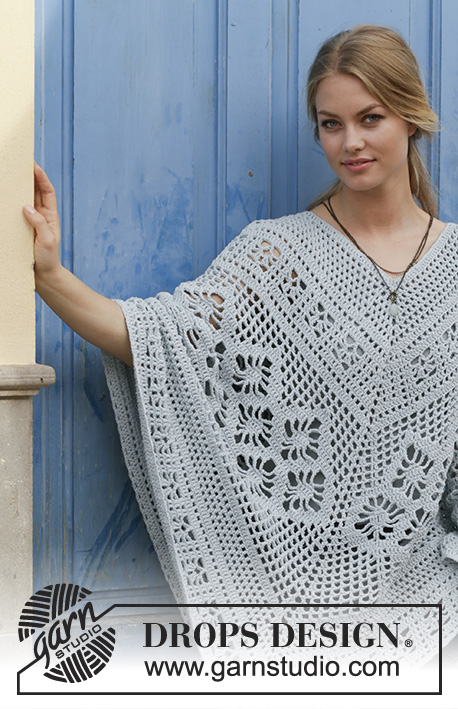 |
|||||||||||||||||||||||||||||||||||||||||||||
Crocheted poncho with lace pattern, worked top down. Size: S - XXXL Piece is crocheted in DROPS Paris.
DROPS 188-27 |
||||||||||||||||||||||||||||||||||||||||||||||
|
INFORMATION FOR PATTERN: PATTERN: See diagrams A.1 to A.5. CROCHET INFO: The first double crochet at the beginning of round are replaced with 3 chain stitches. Finish round with 1 slip stitch in 3rd chain stitch at beginning of round, then work slip stitches until middle space. DECREASE TIP - WORK 2 TREBLE CROCHETS TOGETHER: Work 1 treble crochet around chain space below but wait with last pull through (= 2 stitches on hook), skip 1 single crochet and work 1 treble crochet around next chain space but on last pull through pull yarn through all loops on hook. INCREASE TIP: Increase 1 double crochet by working 2 double crochets in same stitch. ---------------------------------------------------------- PONCHO: Poncho is worked in the round, top down. First increase mid front, mid back and on each side of each shoulder, then increase only mid front and mid back. Work 156-166-166 chain stitches on hook size 4.5 mm/US 7 with Paris and form a ring with 1 slip stitch in first chain stitch. Work 3 chain stitches - read CROCHET INFO! Then work 1 double crochet in each of the next 5-3-3 chain stitches, * skip 1 chain stitch, work 1 double crochet in each of the next 5 chain stitches *, work from *-* 25-27-27 times in total = 130-138-138 double crochets + 3 chain stitches at beginning of round. REMEMBER THE CROCHET GAUGE! Now insert 6 markers from beginning of round as follows (without working): Insert 1 marker in 1st double crochet on round (i.e. in double crochet after the 3 chain stitches = mid back), skip 24-26-26 double crochets, insert 1 marker in next double crochet (= shoulder), skip 14 double crochets, insert 1 marker in next double crochet (= shoulder), skip 24-26-26 double crochets, insert 1 marker in next double crochet (= mid front), skip 14 double crochets, insert 1 marker in next double crochet (= shoulder), skip 26-26-26 double crochets, insert 1 marker in next double crochet (= shoulder), there are now 6 double crochets between last marker and beginning of round. WORK A.1 AS FOLLOWS: Work 1st round as follows: Work * A.1A in first/next double crochet with marker (= mid front/mid back), repeat A.1C 12-13-13 times in total, A.1D in next double crochet with marker (= shoulder increase), repeat A.1E 7 times in total, A.1D in next double crochet with marker (= shoulder increase), A.1E 12-13-13 times in total *, work from *-* 2 times in total. Work 2nd round as follows: Work * A.1A (= mid front/mid back), A.1B, repeat A.1C 12-13-13 times in total, A.1D (= shoulder increase), repeat A.1E 7 times in total, A.1D (= shoulder increase), A.1E 12-13-13 times in total, A.1F *, work from *-* 2 times in total. Continue to and with 6th-7th-8th round in diagram A.1. There are now 108-128-132 stitches between chain space mid front and mid back (= 216-256-264 stitches + 2 middle spaces on round). Piece measures approx. 8-9-10 cm / 4" in crochet direction (measure down from the shoulder from the cast-on edge). ROUND WITH DOUBLE CROCHETS: Work 1 round with double crochets, work (2 double crochets, 3 chain stitches, 2 double crochets) around middle space, and adjust AT THE SAME TIME number of double crochets to decrease/increase as follows: S/M – XXL/XXXL: Increase 1-1 double crochet along each of the sides between mid front/mid back (= 2-2 double crochets in total) – read INCREASE TIP L/XL: Decrease 7 double crochets along each of the sides between mid front/mid back (= 14 double crochets in total) – read DECREASE TIP There are now 113-125-137 stitches between chain space mid front and mid back (= 226-250-274 stitches + 2 middle spaces on round). NOTE! Do not increase on each side of each shoulder onwards, but only mid front and mid back on poncho! WORK A.2/A.3 AS FOLLOWS: Work * A.3A (= middle space), A.3B over 3 double crochets, A.2 (= 12 stitches) 9-10-11 times in total in width, A.3C over the next 2 double crochets *, work from *-* 2 times in total. On 9th round increase 12-24-36 double crochets evenly on each side of A.3A (i.e. increase 24-48-72 double crochets in total on round) = 145-169-193 double crochets between chain space mid front and mid back (= 290-338-386 double crochets in total + 2 middle spaces on round) – read INCREASE TIP. Piece measures approx. 19-20-21 cm / 7½"-8"-8¼" in crochet direction from cast-on edge. WORK A.4/A.5 AS FOLLOWS: Work * A.5A (= middle space), A.5B, A.4 (= 24 stitches) 6-7-8 times in total in width, A.5C over next double crochet *, work from *-* 2 times in total. When A.5 has been done vertically, 19 rounds have been worked, continue on 20th round as follows: Work * A.5D, A.5E over 1 double crochet, A.5F 7 times in total in width, A.4 (= 24 stitches) 6-7-8 times in total in width, A.5F 7 times in total in width, A.5G *, work from *-* 2 times in total. When A.4/A.5 have been worked, there are 211-235-259 double crochets between chain space mid front and mid back (= 422-470-518 double crochets in total + 2 middle spaces on round). Piece measures approx. 46-47-48 cm / 18"-18½"-19" in crochet direction from cast-on edge. WORK 2ND AND 3RD ROUND IN A.1 AS FOLLOWS: Begin around one middle space and begin from 3rd round in diagram. Work * A.1A (= middle space), repeat A.1C until next middle space (work last stitch only over 1 stitch on first round *, work from *-* 2 times in total. Repeat 2nd and 3rd round until 4-8-10 rounds have been worked in total. Piece measures approx. 51-56-59 cm / 20"-22"-23¼" in crochet direction from cast-on edge. ROUND WITH DOUBLE CROCHETS: Work 1 round with double crochets and decrease AT THE SAME TIME 7-5-5 double crochets evenly along each of the sides between mid front/mid back (= 14-10-10 double crochets in total) as follows: Work * (2 double crochets, 3 chain stitches, 2 double crochets) around middle space, then work 1 double crochet in every double crochet and 1 double crochet around every chain stitch until next middle space *, work from *-* 2 times in total = 209-245-269 double crochets between chain space mid front and mid back (= 418-490-538 double crochets + 2 middle space on round). Cut the yarn. WORK A.2/A.3 AS FOLLOWS: Work * A.3A (= middle space), A.3B over 3 double crochets, A.2 (= 12 stitches) 17-20-22 times in total in width, A.3C over the next 2 double crochets *, work from *-* 2 times in total. When A.2/A.3 have been worked, there are 229-265-289 double crochets between chain space mid front and mid back (= 458-530-578 double crochets + 2 middle spaces on round). Piece measures approx. 62-67-70 cm / 24½"-26½"-27½" in crochet direction from cast-on edge. EDGE: Work a finishing edge around the entire poncho as follows: 1 slip stitch in first stitch, * work 3 chain stitches, skip 2 stitches, 1 single crochet in next stitch *, work from *-* the entire round and finish with 1 slip stitch in slip stitch at beginning of round. Fasten off. |
||||||||||||||||||||||||||||||||||||||||||||||
Diagram explanations |
||||||||||||||||||||||||||||||||||||||||||||||
|
||||||||||||||||||||||||||||||||||||||||||||||
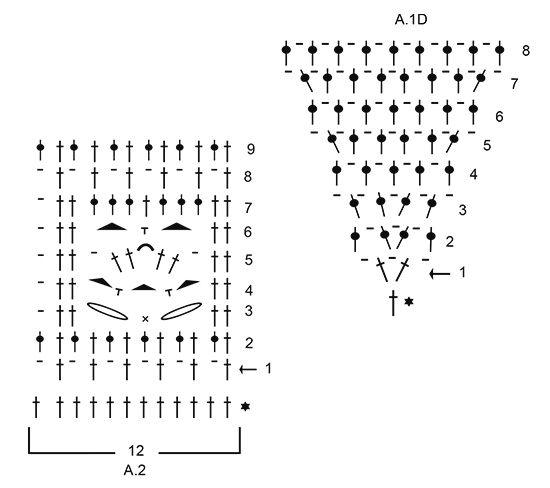
|
||||||||||||||||||||||||||||||||||||||||||||||
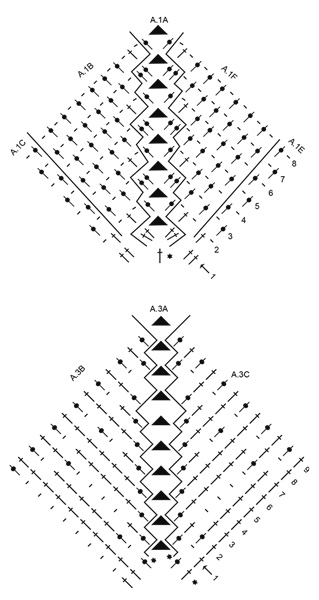
|
||||||||||||||||||||||||||||||||||||||||||||||

|
||||||||||||||||||||||||||||||||||||||||||||||
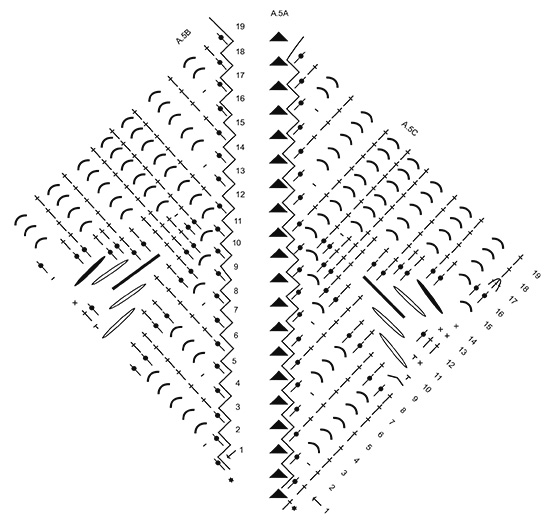
|
||||||||||||||||||||||||||||||||||||||||||||||

|
||||||||||||||||||||||||||||||||||||||||||||||
|
Have you made this or any other of our designs? Tag your pictures in social media with #dropsdesign so we can see them! Do you need help with this pattern?You'll find tutorial videos, a Comments/Questions area and more by visiting the pattern on garnstudio.com. © 1982-2024 DROPS Design A/S. We reserve all rights. This document, including all its sub-sections, has copyrights. Read more about what you can do with our patterns at the bottom of each pattern on our site. |
||||||||||||||||||||||||||||||||||||||||||||||
































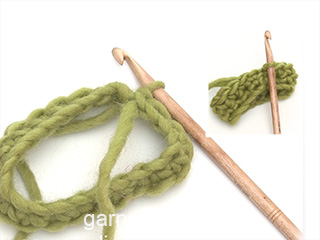
























Comments / Questions (66)
Ok, I see my mistake. So every beginning of a round I do 3 chain stitches. So for example first round of A1 the very first double crochet would be 3 chains? So in A1A that first stich with a marker I would have 3 chains, a double, 3 chains and then 2 doubles? Or do I do the 3 chains where the slip stich from the last round is, then do the first row from A1A?
25.10.2021 - 05:28DROPS Design answered:
Dear Gwennie, once again, I will have to refer to the same part of th epattern (Pattern info), where it tells you, that the first stitch is replased with 3 chain stitch. Replaced and not crocheted in addition. The 3 chain stitch shouéd be made, where the first stitch of the pattern should be. Happy stitching!
25.10.2021 - 06:15Hi, I am wondering if after finishing a row there needs to be a slipstich to connect to the first stitches? Or do I just keep crocheting in a circle?
25.10.2021 - 02:59DROPS Design answered:
Dear Gwennie, please check the "Information for the pattern" section. It says " Finish round with 1 slip stitch in 3rd chain stitch at beginning of round, then work slip stitches until middle space.", so you will have to connect/close the round with a slip stitch. Happy Stitching!
25.10.2021 - 04:38Buonasera, non riesco a capire l'avvio di questo modello: la prima riga di A1C è costituita da due maglie alte o una maglia alta e una catenella ? Grazie per l'aiuto
17.10.2021 - 20:13DROPS Design answered:
Buonasera Irene, i diagrammi si leggono dal basso verso l'alto, per cui la prima riga di A1C sarà 2 maglie alte. Buon lavoro!
24.10.2021 - 20:28I have a question about sizing: if my bust size is about 34 in/86cm, what size should I crochet? The schematic for this pattern isn't very helpful in that regard. Thank you!
25.09.2021 - 17:44DROPS Design answered:
Dear Bekki, we suggest that you take a similar piece and check the measurements and compare to the schematic drawing. Happy Stitching!
27.09.2021 - 03:16Ik heb een probleem met het kiezen van de juiste haaknaald. Met 4.5 krijg ik 10 cm breed en 12 cm hoog. Met 5 wordt het 11 cm breed en hoger. Met 4 wordt het 9 cm breed. Is 4.5 dan toch de juiste keuze?
09.07.2021 - 11:57Jestem na samym poczatku :) Schemat A1. Przerobilam 1 okrazenie i drugie. i wszystko bylo ok. W drugim okrazeniu zrobilam liczbe slupkow/powtorzen jak w opisie i wszystko bylo ok. Trzecie okrazenie A1A, A1B, A1C i A1D OK ale w A1E nie wyszlo mi juz 7 powtorzen jak w drugim okrazeniu tylko wiecej. Czy w kazdym okrazeniu schemat A1E trzeba powtarzac 7 razy? Tylko pomiedzy dwoma A1D wychodzi mi tak. Pozostale czesci wzoru byly ok.
01.04.2021 - 13:57DROPS Design answered:
Witaj Magdo, schemat A.1D rozszerza się i w każdym kolejnym okrążeniu będzie w nim więcej oczek (te oczka są wliczane do tego schematu). Co do schematu A.1E - on się nie poszerza, tzn. w każdym kolejnym okrążeniu będzie tam 14 oczek. Schemat ten będzie powtarzany zawsze 7 razy. Poza schematem A.1D, poszerzać się też będą schematy A.1B i A1.F. Pozdrawiamy!
06.04.2021 - 15:47Witam. Robie rozmimar S/M
01.04.2021 - 00:01DROPS Design answered:
Dobrze, napisz jeszcze proszę, w którym momencie w opisie jesteś? Które dokładnie schematy przerabiasz?
01.04.2021 - 13:41Zupelnie nie zgadza mi sie liczba slupkow w czesci AE pomiedzy AD. Pierwszy i drugi rzad mam ok wg opisu 7 powtorzen AE ale w rzedzie 3 bede miala wiecej niz 7. Tak powinno byc czy cos robie zle?
31.03.2021 - 11:35DROPS Design answered:
Witaj Magdo, jaki rozmiar wykonujesz?
31.03.2021 - 22:48Kompletnie nie mam pojecia jak czytac schemat A1.A (a nie jestem poczatkujaca w szydelkowaniu). cCo to sa te zygzaki w pionie?
23.03.2021 - 12:23DROPS Design answered:
Witaj Ewo, zygzaki, o których piszesz wyodrębniają po prostu pewną część schematu, tak aby był bardziej czytelny. Pozdrawiamy!
23.03.2021 - 14:03Efter diagram A.1A + A.1D hvor antal har passet, har jeg nu en del flere masker end de 113 m imellem luftmaskebuerne. Hvor kan det gå galt? Jeg har hæklet stangmasker i luftmaskebuerne og i stangmaskerne i omgangen før
17.02.2021 - 16:59DROPS Design answered:
Hej Susanne, det er svært at gætte sig til hvor det er gået galt. Vil du skrive hvilke størrelse du hækler og hvilket stykke du er kommet til i opskriften, så kan vi muligvis prøve at sætte os ind i arbejdet :)
19.02.2021 - 14:48